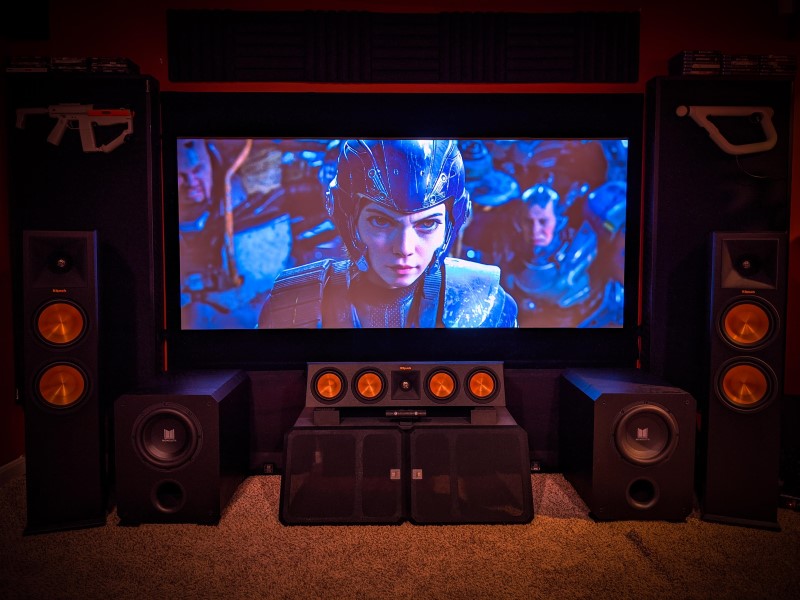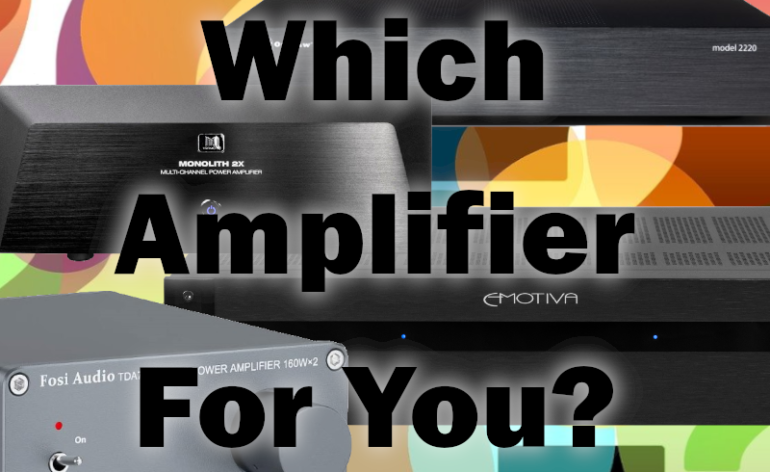Best Uses of an External Amplifier in a Home Theater – Along with Recommendations!
Around here, we often steer people away from external amplifiers. Not because they aren’t useful in home theater, but often because of the reason they want to buy an external amplifier. They think that an external amp will make their speakers sound better or somehow change their listening experiences. A good amplifier doesn’t work this way. Instead, all it does is provide more power to your speakers (usually more than your AV receiver can push). But there is rarely a need for more power. However, that doesn’t mean that they are useless. Here are some of the best uses of an external amplifier in home theater.
Adding Channels
The best reason for adding an external amplifier to your home theater is because you simply don’t have enough in your AV receiver. Many receivers these days can power seven or nine speakers but can process more. They require that you buy an external amplifier if you want to use those channels in your home theater. Well, you really have no choice other than to buy an external amp. But which one?
We love the Fosi Audio TDA7498E. This two-channel amplifier sports 60 watts per channel into 8-ohms (don’t look at the claims on Amazon, they are misleading). If you are thinking that your receiver has more power than that, you are likely correct. But you’ll be adding this amp to power your surround or Atmos speakers. These speakers will be very close to you and really don’t need a ton of power. For $75, you really can’t beat this little amplifier. Don’t know how to set it up? We have an article just for you!
Powering a Second or Third (or More) Zone
It is one thing to have a banging home theater. It is completely different to have a system that can distribute music throughout your entire house! Whole-home audio can be very complex, but it doesn’t need to be. If you really only want to have the ability to play some music in a second area, many home theater receivers can do that. If you aren’t using all the internal amplifiers, they can even power those speakers. But if you are using your internal amps, you’ll need a solution to get that audio to the other room.
Sure, you can use the Fosi amp listed above to do it. That will work fine. But what if you don’t want to run all those wires? What if what you want is to wirelessly stream that music to a device in a second room that reproduces the audio? If you have a more recent Denon or Marantz, you can use their Heos system. Yamaha has MusicCAST. But those solutions are proprietary and expensive.

We recommend getting one of the wireless audio adapters from SVS. They have two. The Wireless Audio Adapter will work in most situations. The Tri-Band Wireless Audio Adapter will work in more challenging installations. You can order them both and keep the one that works. This solution still uses an external amplifier (we still think the Fosi amp is best) but at least it won’t be in your home theater. Instead, you’ll have a transmitter in your home theater and a receiver that will be used in your second zone with the Fosi external amplifier. It still isn’t a truly wireless solution, but it gets very close.
Lowering Noise Floor
When you have a lot of amplifiers inside one receiver, you can sometimes run into issues. The most common one is increased noise floor. If you try to use every amplifier in your receiver, you can end up with a noise floor (a hiss) that can be heard from your seat. That is not good. Luckily, the fix is the same as our first solution – adding an external amplifier to take some of the load off the receiver. Again, we are going to suggest using the Fosi amp and connecting it to your surround or Atmos speakers. This will lower the load on the AV receiver and eliminate any increased noise floor.

What About The Front Three Speakers?
When people buy an external amplifier for their home theater systems, the best uses, they say, are for the front three speakers. These are the speakers that make the most sound so they need the most power. The fact is, most of the time your receiver has more than enough power. There are times when you do need an external amplifier, but it usually isn’t because your speakers are lacking power. If your speakers were power-hungry, you’d know.
What really happens is that people start shopping for amplifiers and they fall down the shopping rabbit hole. They start with a small amp to add those two channels their receiver can’t power and end up buying a full seven or nine-channel amp. They didn’t need it, but it makes them happy to own it. That’s fine. The reality is that all you really needed was a couple of extra amplifier channels to power speakers you couldn’t with the receiver, or to take some of the load off your receiver. And you can do that for very little money.
But What if I Want or Need an Amp for my Front Speakers?
Okay, if you really want, or legitimately need, more power for your front speakers, you are going to need a more powerful amplifier than the Fosi. The problem as of this writing is supply. Amplifiers keep going in and out of stock. So, here are some options. Most of these have many different versions with different numbers of channels. Pick the one that fits your need and price point. We’ve linked, except where noted, to two-channel amplifiers:
- Emotiva BasX A2 Stereo Amplifier (LINK) – $449
- Outlaw Audio MODEL 2220 (LINK) – $349 – Note: this is mono-amplifier, you’d need to buy two for stereo
- Monolith by Monoprice 2×200 Watt Amplifier (LINK) – $1099
- ATI Amplifiers (LINK) – Dealer only, expect to start over $2000 for two channels
Any of the above amplifiers will work for your front speakers. Just as a side note, ATI makes the Monoprice amplifiers. While the ones they make for themselves are better, you are unlikely to notice a difference in your home theater. If you want a solid amp with a non-existent noise floor, any of these amps will do. If you can find one.




This is an amazing article Tom. Thank you for the insignt!
Thanks for this article it was very very informative